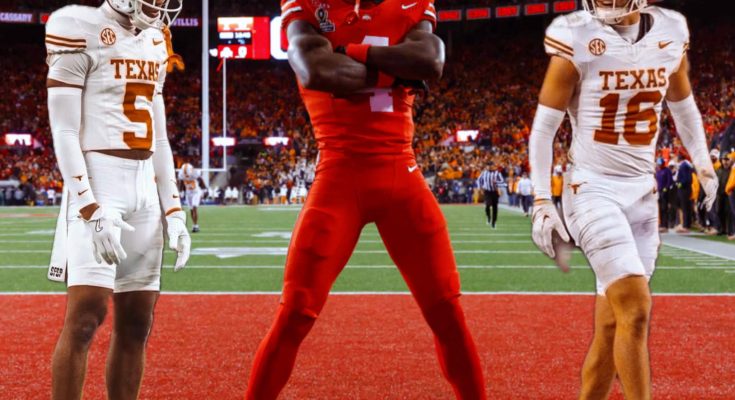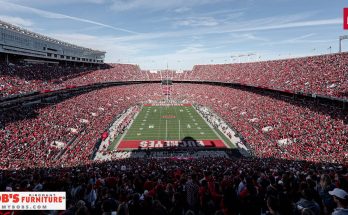According to Pro Football Focus, the Texas Longhorns currently boast the best defensive backfield in all of college football, a unit that has quickly become the backbone of a team with national championship aspirations. Much of that acclaim is centered around two players in particular: sophomore cornerback Malik Muhammad and veteran safety Michael Taaffe. Together, they have elevated the Longhorns’ secondary from an area of uncertainty into one of the most feared defensive groups in the nation. With their unique blend of youth, experience, speed, and football IQ, the duo has been integral in shutting down opposing passing attacks, limiting big plays, and giving the Longhorns the confidence to play aggressively on the defensive front. But now, that secondary faces perhaps its greatest test of the season as the Longhorns prepare to take on the Ohio State Buckeyes, led by the most highly touted wide receiver in the country, freshman sensation Jeremiah Smith.
For much of the offseason, analysts wondered if Texas’ defensive backs would hold up against the elite passing offenses they were bound to face in pursuit of a playoff run. The Longhorns’ defense had been solid but inconsistent in years past, at times allowing big plays that undermined otherwise strong performances. Enter Malik Muhammad, who came onto the scene as a freshman with exceptional technique and ball skills, immediately proving he was more than capable of handling top assignments. Now as a sophomore, he has already shown remarkable growth, blending confidence with discipline and becoming a true lockdown corner. His ability to shadow receivers across the field, disrupt timing routes, and turn potential completions into deflections has given defensive coordinator Pete Kwiatkowski the flexibility to play tighter coverage and free up the pass rush.
Beside him, Michael Taaffe provides the experience and leadership that any elite secondary requires. A seasoned safety with excellent instincts, Taaffe has not only been a reliable last line of defense but also a quarterback of the secondary, ensuring that the Longhorns are rarely caught out of position. His knack for diagnosing plays before they fully develop has helped Texas eliminate deep passing threats and force opposing quarterbacks into mistakes. Together, Muhammad and Taaffe give the Longhorns a rare combination: a young, rising star capable of erasing elite wideouts and a veteran safety who keeps the entire unit composed and disciplined.
That balance has been the foundation of Texas’ rise on defense, but the looming challenge against Ohio State is unlike anything they have yet encountered. Jeremiah Smith, the crown jewel of the Buckeyes’ latest recruiting class, has been hyped as a once-in-a-generation talent at wide receiver. Standing at 6’3” with elite speed and physicality, Smith has already begun to justify that hype with highlight-reel plays, showcasing an ability to not only stretch the field vertically but also win contested catches against seasoned defenders. For a Texas secondary praised as the best in college football, Smith represents the ultimate litmus test. Can Muhammad contain him on the outside? Can Taaffe and the safeties prevent Smith from breaking open a game with one or two explosive plays?
The stakes make this matchup all the more fascinating. Both Texas and Ohio State enter the weekend with playoff implications hanging in the balance. A win against the Buckeyes would bolster the Longhorns’ credibility as a legitimate national title contender, proving that their secondary can hold up even against an elite wideout in a high-pressure environment. Conversely, a dominant performance from Jeremiah Smith could expose weaknesses in the Longhorns’ defensive backfield and shift the momentum toward Ohio State’s playoff campaign.
From a schematic perspective, the battle will hinge on how much man-to-man responsibility the Longhorns are willing to place on Malik Muhammad. If they trust him to shadow Smith for much of the game, it allows Taaffe and the safeties to focus on limiting other Ohio State weapons, such as their deep stable of receivers and their athletic tight ends. But even the most gifted cornerbacks rarely shut down talents like Smith completely, which means Taaffe will likely find himself involved in bracket coverages or deep help assignments designed to limit Smith’s impact. The question then becomes whether the rest of the Texas defense can hold up without giving up easy completions elsewhere.
There is also the matter of pressure. The Longhorns’ pass rush has been an underrated factor in the secondary’s success, as forcing opposing quarterbacks into hurried throws makes the job much easier for defensive backs. If Texas can collapse the pocket and prevent Ohio State’s quarterback from setting his feet, Smith’s impact may be muted no matter how talented he is. But if the Buckeyes’ offensive line gives him time to operate, Smith’s route-running and size advantage could stress even the best secondary in football.
Jeremiah Smith has already shown a rare ability to adjust to different coverages, making plays against both tight man coverage and soft zones. His chemistry with the quarterback, though still developing, has flashed in crucial moments, suggesting that the Buckeyes are ready to lean on him even in a big game environment. The Longhorns, meanwhile, have prided themselves on making opponents one-dimensional, forcing teams to abandon the deep ball and rely on shorter, less explosive plays. This tug-of-war between Smith’s explosiveness and the Longhorns’ defensive discipline is likely to define the outcome of the game.
One of the intangibles often overlooked in these matchups is the mental edge. Jeremiah Smith, despite his youth, plays with confidence bordering on swagger, often feeding off the energy of the crowd and using big plays to swing momentum. Malik Muhammad, likewise, is known for his competitive fire, rarely backing down from a challenge and often thriving against top receivers. The one-on-one battles between them could become must-watch moments, each rep carrying the weight of not just a play but the psychological tone of the entire contest. Should Muhammad get the best of Smith early, it could frustrate the young receiver and disrupt Ohio State’s offensive rhythm. Conversely, if Smith makes a few early plays, it could energize the Buckeyes’ sideline and put Texas on its heels.
Another factor to consider is the role of Michael Taaffe in disguising coverages. Ohio State will undoubtedly attempt to identify and exploit matchups favorable to Smith, moving him around the formation to test different defenders. Taaffe’s ability to adjust coverages on the fly, shift safeties into position, and anticipate Ohio State’s adjustments could be critical in preventing Smith from finding mismatches. His experience against high-level offenses in the Big 12 and now in the SEC has prepared him for these moments, and his leadership will be essential if the Longhorns are to keep the Buckeyes contained.
This game also offers broader implications beyond the scoreboard. For Texas, which has long sought respect on the national stage, shutting down Jeremiah Smith and Ohio State’s passing game would send a resounding message that their defense is championship caliber. It would validate the claims of Pro Football Focus and cement Muhammad and Taaffe as one of the premier defensive duos in the sport. For Ohio State, a breakout performance from Smith on such a stage would further solidify the program’s reputation as “WRU” and establish him as the next great Buckeye receiver following in the footsteps of Chris Olave, Garrett Wilson, and Marvin Harrison Jr.
The buildup to Saturday’s clash has already generated massive attention, with analysts debating whether Texas’ secondary is truly elite or simply untested, and whether Smith is ready to dominate a defense that knows he will be the focal point. Fans of both programs are eager to see which narrative proves true. Will Muhammad and Taaffe stand tall, justifying the hype and keeping the Longhorns’ playoff dream alive? Or will Smith announce his arrival as the next unstoppable force in college football, too talented for even the nation’s best defensive backfield to contain?
Whatever the outcome, the matchup is destined to be one of the most pivotal and exciting of the season. On paper, it is strength against strength: the top secondary against the top young receiver. On the field, it will come down to execution, composure, and the ability to rise to the occasion when the moment is biggest. For Malik Muhammad and Michael Taaffe, Saturday is an opportunity to prove that they are more than just a highly ranked secondary—they are the foundation of a championship defense. For Jeremiah Smith, it is the chance to turn potential into legend, to take the first step toward becoming the next iconic Buckeye playmaker.
As kickoff approaches, anticipation continues to build, with every storyline pointing toward an epic showdown. College football thrives on these kinds of battles—when great players meet on the grand stage and legacies are defined not in hype or prediction but in performance under the lights. And for all the talk about Texas’ defensive backfield and Ohio State’s star receiver, only Saturday will reveal the truth of who has the upper hand. Until then, the debate rages on, and fans can only imagine how the best secondary in football will fare against the most electrifying young receiver in the game.


